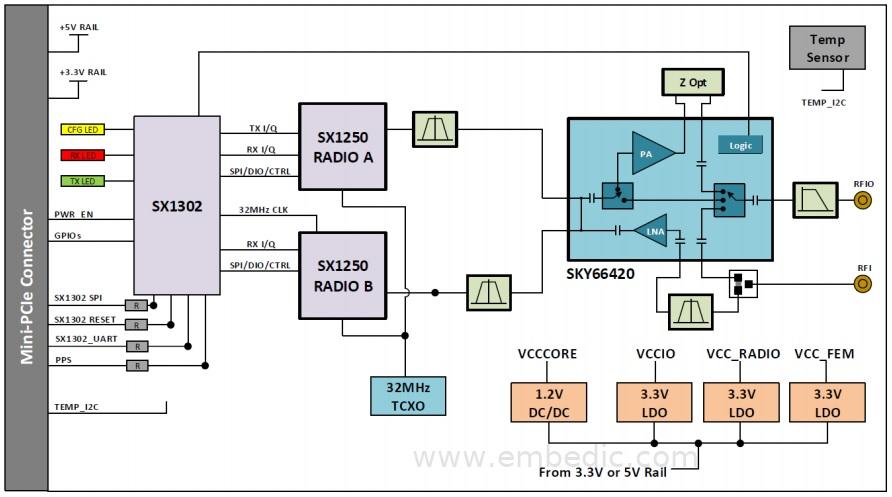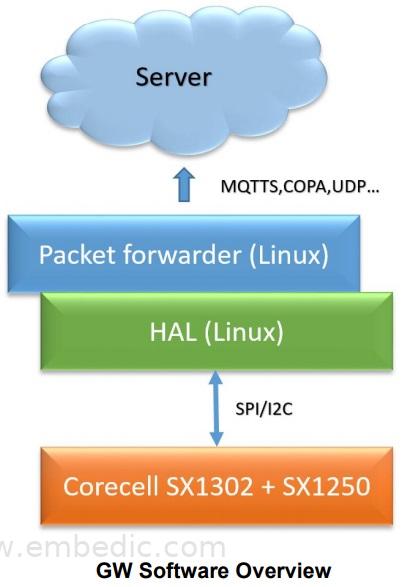One of the advantages of this solution is to use the mPCIe interface module made by the Semtech reference design. The interface is an industry standard and can be used by users in existing industrial computers or Raspberry Pi.
Solve problem one (use mPCIe interface to quickly connect):
One of the advantages of this solution is to use the mPCIe interface module made by the Semtech reference design. The interface is an industry standard and can be used by users in existing industrial computers or Raspberry Pi.

figure 1
Solve problem two (reduce size and cost):

figure 2
Another advantage of this solution is the use of Raspberry Pi Zero. The reason for choosing this system is to take advantage of its low power consumption and provide 1GHz single-core CPU, 512MB memory, Mini-HDMI port, Micro -USB port, Micro-USB power supply, 40-ping connector. The price of the WIFI version with 802.11n is only US$10, and if there is no WIFI, it only costs US$5.
Solve problem three (reduce system power consumption):
As shown in Figure 3, we can see that the power consumption of Pi Zero has dropped from 600mA to 100mA compared to the Pi 4 version, which is about five-sixths less.

figure 3
In the two pictures in Figure 4 and Figure 5, we can see that the main chip SX1302 also reduces power consumption a lot compared to the previous generation product SX1301.

Figure 4

Figure 5
Block diagram and description of main components

Image 6
As shown in Figure 6, the reference design for EU868 and US915 includes a multi-channel SX1302 baseband IC and two SX1250 RF transceivers. In addition, a front-end module that can provide 27dBm output and the necessary filters and power supplies are needed to form an 8-channel LoRa gateway that can provide high performance.

Figure 7
For the CN490 channel architecture shown in Figure 7, the reference design includes a multi-channel SX1302 baseband IC, two SX1250 RF transceivers, and all necessary filters and power supplies.
In the mPCIe transfer board circuit diagram in Figure 8 below, we can see that the four lines of SCK, MISO, MOSI, CSN in SPI that need to be connected to the Raspberry Pi; SCL & SDA of I2C; 3V3, GND and Reset in the power supply , Power EN has 10 lines.

Figure 8
As the pins of Raspberry Pi 3.0 and ZERO are the same, we use Raspberry Pi 3.0 to guide how to connect to the mPCIe transfer board in Figure 8.

Picture 9
How to perform Linux updates and basic settings
Update Linux ~ Enter the update by following the command
-$ sudo apt-get update
-$ sudo apt-get upgrade
-$ sudo apt-get dist-upgrade
-$ sudo rpi-update
Install Git Service ~ Restart after input and execution according to the following command)
-$ sudo apt install git
Turn on Linux SPI/I2C/UART (Enter the option after entering the command and choose to start SPI/I2C/UART)
-$ sudo raspi-config:

Picture 10
Enter the reboot command to restart)
-$ sudo reboot
Get the latest Semtech software package from LoRa®Github (Internet connection is required)
-$ git clone https://github.com/Lora-net/sx1302_hal.git
-$ cd ~/sx1302_hal/
-$ make clean all
-$ ssh-keygen -t rsa
The following two commands are executed to avoid entering the user password when installing the file
-$ ssh-copy-id -i ~/.ssh/id_rsa.pub pi@localhost
You should install all programs after entering the raspberry pi password
-$ make install
-$ make install_conf
Copy executable files such as global_conf.json to the bin folder
Use command to read gateway ID
$ ./chip_id
Add the gateway ID to the global_conf.json file
"gateway_ID": "0x0016c001ff1801e6",
After entering the Packet Forwarder file directory, execute the program:
$ cd ~/sx1302_hal/bin/
$ ./lora_pkt_fwd –c global_conf.json.sx1250.EU868

Picture 9
A test environment explanation
In this program, we set the test environment layout as shown in Figure 10

Figure 10
1. LoRaWAN node ~ Use the LT501 tracker produced by WorldCom to send data to the gateway.
2. LoRaWAN Gateway ~ The gateway of Raspberry Pi Zero W and SX1302 combination.
3. Terminal ~ Use a PC to connect to the gateway under the same network segment via VNC.
2 Demonstration of actual test environment and received data

Picture 11

► Scenario application diagram

► Product entity diagram

► Showcase photos


► Scheme block diagram

► Core technical advantages
The feature of this solution is the use of Semtech, a new generation of LoRa® gateway chip SX1302. Its main enhanced function is to reduce the current consumed, which simplifies the heat dissipation design of the gateway and the size and application range of the product. Furthermore, the reduced current consumption can also reduce the required power input power, which allows developers to have more power options. The SX1302 also reduces the cost of the bill of materials. For example, the SX1302 uses a single 32 MHz clock source, but with reduced materials, it can handle higher cost flows than previous equipment. In addition to supporting the previous parameters, the chip has enhanced the ability to support SF5 and SF6 to provide higher communication capacity. It adds 8 to handle high-speed SF5 and SF6 data packets, while the other 8 are still in charge of SF7-SF12 flow. The architecture is designed to reduce power consumption, making it easier to embed.
► Solution specifications
Chipset ~ SX1302 series
Frequency ~ Front End chip matched as follows
SX1255 400-510 MHz
SX1257 862-1020 MHz
SX1250 150-960 MHz
Working voltage ~ 3.0V ~ 3.6V (I/O)
1.1V ~ 1.3V (Core)
Power consumption ~ SX1302 Typical 28mA
Raspberry Pi Zero 100mA (Official Web)
Transmission media ~ SPI
Transmission distance ~ 1KM~10KM (0.81Kbps)
Receiving sensitivity ~ -141 dBm SF12 Sensitivity, LoRa 125 kHz bandwidth
Working temperature ~ -40°C~85°C
Size ~ size 7mm X 7mm X 0.75mm
IC MCU 32BIT 256KB FLASH 144BGA
IC MCU 16BIT 128KB FLASH 64TQFP
IC MCU 32BIT 256KB FLASH 64LFBGA
IC MCU 32BIT 64KB FLASH 64TQFP
1
2
3
4
5
6